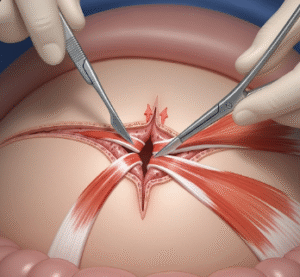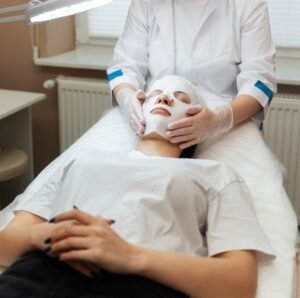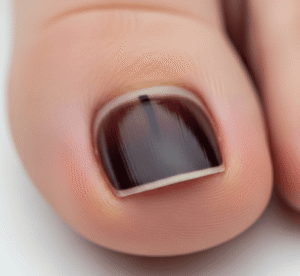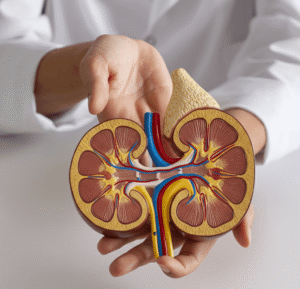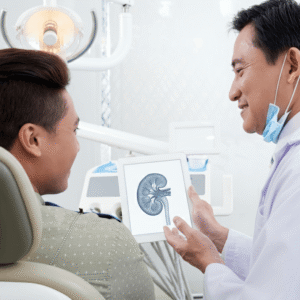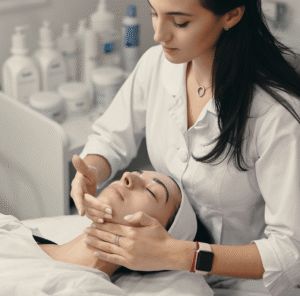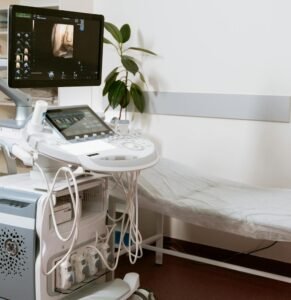What it is
→ Microneedling drug delivery is an advanced skin treatment that combines microneedling (creating controlled micro-channels in the skin using fine needles) with the application of active drugs, serums, or bioactive compounds.
→ The tiny punctures created by microneedling allow medications and skin boosters to penetrate deeper into the dermis, enhancing their absorption and effectiveness compared to topical application alone.
→ Depending on the skin concern, active agents may include:
- Tranexamic acid → for melasma and pigmentation.
- Vitamin C → for brightening and antioxidant protection.
- Hyaluronic acid → for hydration and plumping.
- Growth factors or peptides → for anti-aging and regeneration.
- Platelet-rich plasma (PRP) → for collagen stimulation and healing.
- Botulinum toxin (micro-Botox) → for pore tightening and oil control.
→ In Korea, microneedling drug delivery is widely performed in dermatology clinics, often marketed as MTS (Microneedle Therapy System) or combined with derma rollers, automated pens, or RF-microneedling devices.
Why it’s done
→ Microneedling drug delivery is performed to:
- Treat pigmentation (melasma, freckles, sunspots).
- Reduce acne scars and PIH (post-inflammatory hyperpigmentation).
- Improve skin texture and tone.
- Boost hydration and elasticity.
- Stimulate collagen production for anti-aging.
- Enhance absorption of medical-grade serums and injectables.
→ It is especially popular in Korea because it delivers noticeable results without long downtime compared to stronger lasers or peels.
Alternatives
→ Alternatives to microneedling drug delivery include:
- Topical serums and creams → less effective due to poor skin penetration.
- Chemical peels → improve skin turnover but don’t deliver drugs into deeper layers.
- Laser-assisted drug delivery → fractional lasers create micro-channels for serum infusion.
- Mesotherapy injections → deliver drugs via multiple tiny injections, but more invasive.
→ Microneedling offers a middle ground: more effective than topicals, less invasive than injections.
Preparation
→ Before microneedling with drug delivery, patients should:
- Avoid sun exposure and tanning for 1–2 weeks.
- Stop retinoids, AHAs, BHAs, and exfoliants for at least 3–5 days.
- Avoid blood-thinning medications (aspirin, some supplements) if possible.
- Cleanse the skin thoroughly before the session.
- Apply numbing cream in clinic for comfort.
→ Korean clinics typically run a skin analysis to select the best drug cocktail for individual skin needs.
How it’s Done
→ A typical microneedling drug delivery session includes:
- Cleansing & numbing → skin is cleansed and numbing cream applied for 20–30 minutes.
- Microneedling device → a derma pen or automated microneedling system creates controlled micro-injuries.
- Drug/serum application → tranexamic acid, vitamin C, PRP, or customized cocktails are infused immediately during microneedling to penetrate deeper.
- Soothing mask or cooling therapy → applied afterward to calm skin.
- Sun protection → broad-spectrum sunscreen applied before leaving.
→ Session time → 45–60 minutes.
→ Treatment cycle → 3–6 sessions spaced 4–6 weeks apart for optimal results.
Recovery
→ Recovery is mild compared to aggressive resurfacing:
- Day 1 → redness, mild swelling, skin feels tight (like a sunburn).
- Day 2–3 → slight flaking or peeling may occur.
- Day 4–7 → skin returns to normal with visible brightness and smoothness.
→ Aftercare includes:
- Apply soothing and hydrating serums (hyaluronic acid, cica, panthenol).
- Avoid makeup, saunas, and heavy workouts for 24–48 hours.
- Do not use harsh skincare (retinoids, acids, scrubs) for 5–7 days.
- Use SPF 50+ sunscreen daily to prevent pigmentation.
Complications
→ While safe, possible side effects include:
- Temporary redness, swelling, or pinpoint bleeding.
- Post-inflammatory hyperpigmentation (PIH) if aftercare is neglected.
- Infection risk if performed with poor sterilization.
- Allergic reaction to infused drug/serum (rare).
- Scarring (very rare, usually with overly aggressive treatment).
→ In Korean clinics, risks are minimal due to sterile technique, advanced devices, and dermatologist supervision.
Treatment options in Korea
→ Korea is highly advanced in microneedling drug delivery protocols, with a strong focus on pigmentation, scar treatment, and anti-aging:
- Customized cocktails → tranexamic acid, vitamin C, PRP, peptides, and glutathione tailored for each patient.
- RF-microneedling systems → combine microneedling with radiofrequency for deeper collagen remodeling.
- Pain-free methods → high-quality numbing creams and cooling devices.
- Post-treatment care → soothing masks, stem-cell serums, and LED therapy to speed recovery.
- Combination therapies → often paired with laser toning or chemical peels for stubborn pigmentation.
- Medical tourism packages → clinics provide English-speaking staff, aftercare kits, and long-term follow-up support for international patients.
→ With cutting-edge technology, tailored formulations, and a global reputation for pigmentation expertise, Korea is one of the best destinations for microneedling drug delivery treatments.


